Archived Article Detail
By Thomas P. Moore
Need to search for a keyword, title or article on this page? On your keyboard, hold down the “Ctrl” and “F” key and a “Find in page” box will appear at the bottom of your screen. Type in your keyword and check the “Highlight All” box and like magic your keyword will appear highlighted as you scroll up and down the page!
WHAT’S NEW IN THE MINERAL WORLD ARCHIVE – posted on 10/21/2008
October 21, 2008
Update
I am (psychologically) packing my bags for the Munich Show—I leave in a week for that exciting event—but meanwhile, here’s a short, blog-like update to the October 1 installment of this feature—still available just below.
New Website. Robin Rennie (robin@crystalclassics.co.uk) informs me that a wall-to-wall overhaul of the website of Ian Bruce’s Crystal Classics has just been completed. For awhile now this dealership has distinguished itself by its offerings of top-quality specimens, especially of the old-classic type, especially especially of old English classics, and, to quote Robin, “we have improved the functionality [of the site] so it is much better for searching for specimens by either name or location. We also have a new ‘Hall of Fame’ where we can showcase some of our best pieces that we might have for sale in our showroom or at shows, and pieces that we have sold. We will be starting off with a series of English specimens from the Philadelphia Academy; these are pieces that we put aside for the web, so they have not gone to shows already and been cherry-picked. We will also have updates coming up of a large Tsumeb collection, plus lots of colorful Moroccan pieces, and also many English specimens from the Ian Acworth collection that we acquired midyear.” To visit the new site and to view the newly posted material, use the link www.crystalclassics.co.uk/new-minerals.php. Good hunting, blokes.
New Show. On November 29-30, 2008, a new show kicks off at the Holiday Inn in Craig, Colorado. It is the 2008 Northwestern Colorado Gem & Mineral Show, and it bids fair to be a festive event, including as it does a beer-and-wine-sampling party, with Italian food and live music, at Carelli’s Restaurant, Craig, on the evening of Saturday, November 29. The town of Craig is about half an hour’s drive west of Steamboat Springs, on Highway 40; the area’s attractions include the Strawberry Park Hot Springs, the Museum of Northwest Colorado, Dinosaur National Park, and the Steamboat Springs Ski Resort. The mineral show will be free to the public. Further information, as well as pictures, links and maps, can be found at www.myspace.com/nwcogemshow08. Any dealers interested in setting up at the show (large spaces for $175, smaller ones for $75—payment due by no later than November 14) should contact Matt Maneotis through the web address above, or by e-mailing nwcogemshow08, or by phoning 970-629-3492 or 970-430-9743.
New Minerals at Collector’s Edge. Bryan Lees’ ever-enterprising Collector’s Edge dealership (www.collectorsedge.com) has just gotten in some new lots of beautiful stuff from its worldwide network of contacts. First, the famous Ojuela mine at Mapimí, Durango, Mexico, has been coming into new specimen-producing life for the last few years now, as new mining of ore proceeds at the great 400-year-old mine. While adamite from the locality has been a collectors’ mainstay for decades now (and some new, bright green, specimens of copper-rich adamite have been in circulation within the past year), a very new find, just three months ago, has produced superb adamite specimens in thumbnail to cabinet sizes. The thumbnails are yellow, brilliantly lustrous “pinwheels” and hemispheres, mostly off matrix, while larger specimens typically show yellow to yellow-green, flattened dipyramidal adamite prisms to 2 cm or so on brown gossan matrix. Shown here is a specimen of the latter and less familiar type.
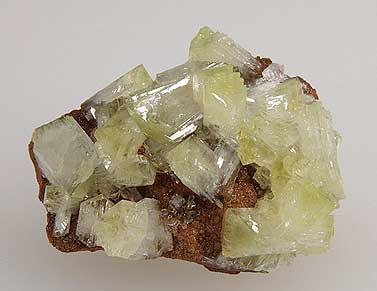
Collector’s Edge specimen and photo.
Colorado-esque rhodochrosite from China has been steadily moving onto our radars, and all the while improving in quality too, for the last few years. Now, Collector’s Edge agents in the Nandan district, Guangxi Zhuang Autonomous Region, have latched onto some major specimens from a 2008 discovery at a very remote site which is being called the Lamo mine. Sharp, red-pink rhombohedral crystals of rhodochrosite rest on a light-colored matrix with associated pyrite, galena, sphalerite and fluorite; shown here is a loose crystal measuring (wow!) 4.5 cm on edge.

Autonomous Region, China. Collector’s edge specimen and photo.
And now, readers, you may read on, in case you have not yet seen the October 1 update.
October 1, 2008
Even while executing the autumnal pivot between the Denver and Munich shows, I’ve found some time to look at what’s new on the web, and to tell you about some highlights. If I have missed anything truly major on somebody’s site, please let me know: these reports still are mightily aided by input from readers, so keep it coming.
New on the Web

Arkenstone specimen and photo.
At the Main Show in Denver a couple of weeks ago, Rob Lavinsky of The Arkenstone (www.irocks.com) showed me something he’d just acquired: 30 loose, fat crystals of partially gemmy purple scapolite from Afghanistan. These crystals were not yet available for sale at the time, but they went up on the Arkenstone website on September 24; thus I didn’t include them in my print report on the Denver Show, but will describe them here, beginning with the news that the scapolite-group species in question has been found to be meionite. The singly terminated, short-prismatic to nearly equant crystals, from 2 to 5 cm, are sharp, clean, and smooth-faced (though they all have chipping along some edges), and all display a nice reddish purple hue, ranging from medium-intense to saturated. Their degrees of gemminess vary: some are almost completely transparent, but “average” crystals show gemmy regions in perhaps 20% of their volumes. Recently, similar specimen lots of scapolite have been said to originate in Badakhshan, Afghanistan—the locality generally also given for the lustrous and thoroughly gemmy, much paler purple scapolite crystals we’ve seen on the market for four years or so. At first Rob was told that these new, thicker, darker crystals also come from the province of Badakhshan, but his sources now have corrected the information, saying that the true locality is the Darra-i-Pech pegmatite field, Nangarhar Province.
For some weeks now the Arkenstone site has also featured some really snazzy specimens showing bright red, partially gemmy spinel crystals embedded in a typical “dirty” white marble, from Luc Yen, Yenbai Province, Vietnam. Matrix pieces to 13 cm across host the crystals, which are octahedral and reach 3 cm on edge. Some of the spinel crystals are spinel-law twinned while others are compound and hoppered-looking—like the exceptional 3.4-cm loose crystal shown here—and all of them, whether gemmy or not, are inherently spectacular thanks to their screaming redness (although, well, a few crystals are more of a purplish red). And Rob offers a few pieces from the same locality which look like the spinel specimens except that the vibrant red crystals are hexagonal prisms, this for the very good reason that they are ruby corundum.
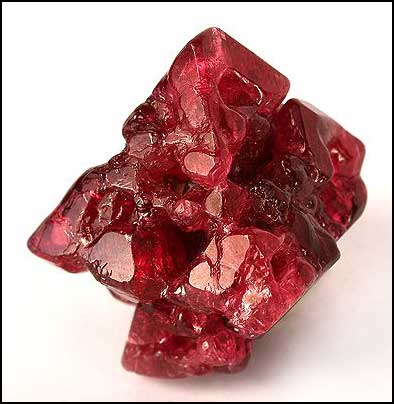
Arkenstone specimen and photo.
While in Vietnam, let’s consider the heliodor beryl crystals which first appeared a few months ago from an unspecified locality, either in Ninh Thuan Province or Kanh Hoa Province. Ibrahim Jameel of Khyber Mineral Company (www.khyberminerals.com) says that both province names have been given by “Vietnamese sources”; Ninh Thuan is given by Bill Larson, who had a couple of fine examples of this new heliodor in the Pala International room at the Holiday Inn in Denver. As Mr. Jameel points out on his site, “the localities of gem crystals from Southeast Asia often remain obscured for years”—the really sticky question, of course, is whether these Vietnamese crystals’ beautiful color is natural or “induced.” Simply put, we don’t know—but you can be sure that the long-prismatic crystals are splendid—sharp, highly lustrous and almost entirely gemmy, with Mr. Jameel’s longest crystals reaching 4 cm. They are of a luscious orange-yellow hue, distinctly darker than the heliodor which comes (supposedly) from Tajikistan, and some show faint color-zoning.
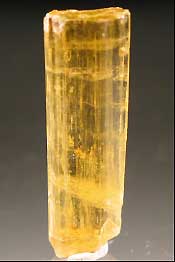
Khyber Minerals specimen and photo.
The orgy of gem-crystal specimens continues, although it now changes venue from Asia to Africa. In an earlier online “what’s new” I described the spectacular lime-green, gemmy crystals of chromium-rich diopside now emerging from the tanzanite mines in the Merelani Hills, Arusha, Tanzania, and in my print report on the Denver Show (coming up in January-February 2009) you’ll read about a fabulous diopside/apatite/graphite pocket opened in December 2007 at the famous “tanzanite place.” Meanwhile, Mike Keim of the web-only dealership Marin Minerals (www.marinmineral.com) has put up some prime gem diopside crystals—about a dozen which Mike selected from 50 which, he says, came from a pocket breached in January 2008. The crystals are lustrous, totally gemmy, and endowed with intricacies of terminal faces; their thicknesses vary, as does the depth of their color, although in general they are quite pale. Some of the diopside crystals show small bits of adhering graphite, but associated species are otherwise lacking. Mike Keim’s crystals range in length between 1.5 and 4.8 cm, and in price between $120 and $400 (except for one exceptional crystal asking $2,500).
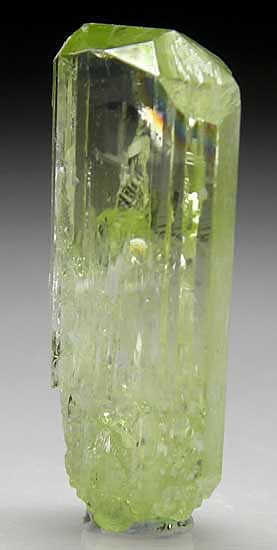
Marin Minerals specimen and photo.
Also with Marin Minerals you’ll find a nice batch of matrix specimens of the gemmy, tangerine-orange spessartine from Loliando, Tanzania which was a major hit at the last Tucson Show (see the May-June 2008 issue). It seems that the African diggers who’d harvested all those loose spessartine crystals as float in near-surface alluvium have lately hit the underlying schist unit in which the crystals had their first homes; now, therefore, matrix specimens are coming out (I saw only one in Tucson in February), although with uncertain prospects for future supplies. Like the loose crystals, these matrix pieces are pricy, but then the gemmy orange trapezohedral spessartine crystals, to golfball size, are extremely pleasant to look at, whether or not half-embedded in mica schist.
It’s always a pleasure to cite a new presence on the web, and herein I greet the Spanish dealership Rod Minerals (www.rodminerals.com), which had its online debut in April of this year. The specialty of the business so far seems to be Chinese and Indian minerals, but much less predictable images are provided by the big, handsome groups of Spanish barite offered in a September 6 update. These clusters of gleaming white and/or pale blue, tabular barite crystals range up to 10 cm across, and they hail from several mines in the La Unión-Cartagena area, Murcia: a region just inland from the Mediterranean coast of southern Spain which has intermittently turned out nice barite specimens but where most of the mines are now closed. The specimen pictured here is from the Victoria mine; others on the update are from the Marisol mine; San Ginés Hill; and, interestingly, a place called Campos de Golf ( = “golf course”).
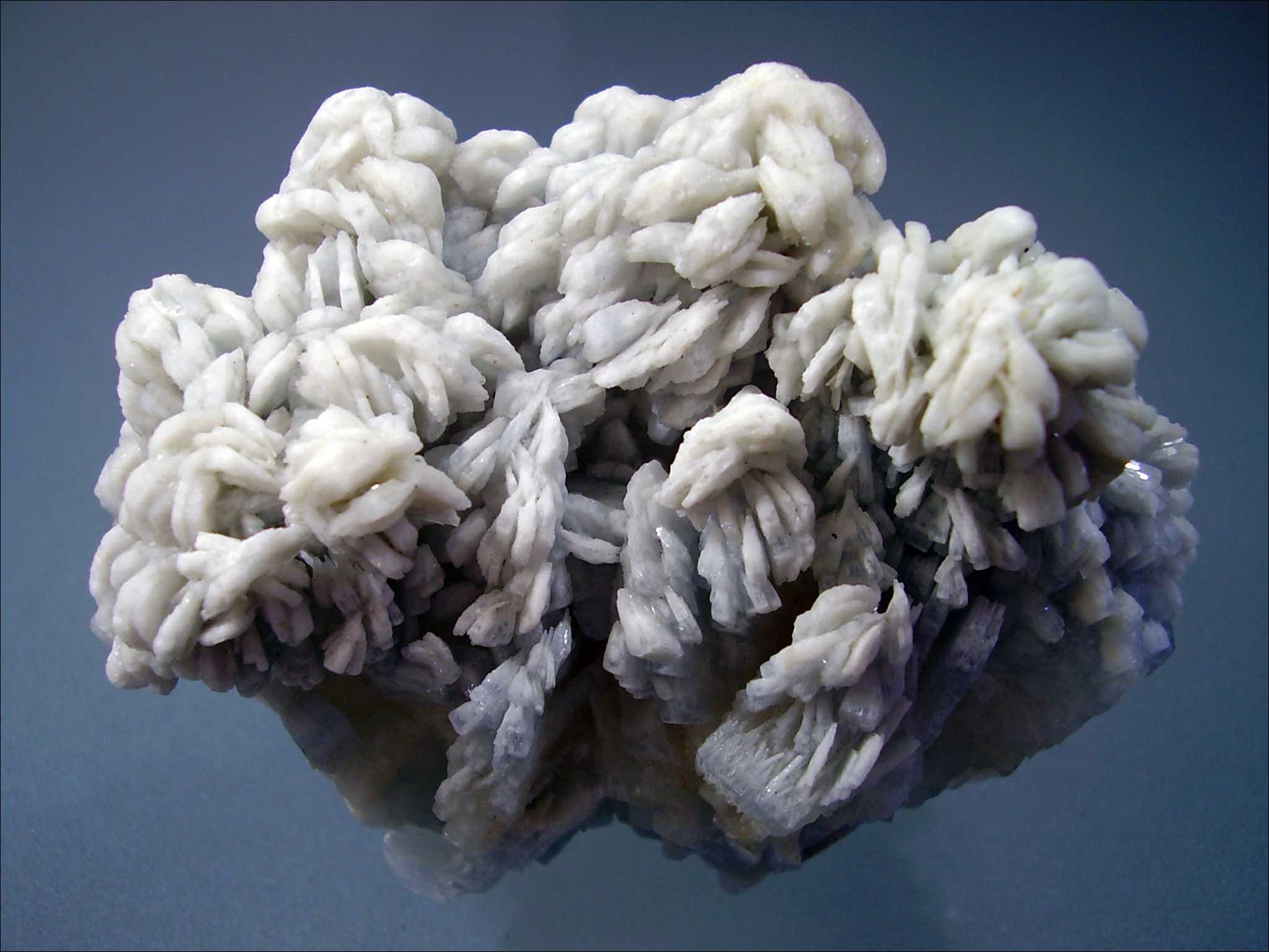
Rod Minerals specimen and photo.
Unquestionably the champ among Spanish web dealers, though, is Jordi Fabre (www.fabreminerals.com), whose website is one of the oldest around and still one of the richest in diverse material from everywhere, much of it fine indeed. Jordi has recently posted many new things, and what struck me most on this surf-through is that he offers good specimens from many older, mostly defunct, classic Spanish occurrences: fine fluorite from La Collada, of course, and calcite from the Emilia and other mines, but also rich selections of gemmy orange sphalerite from the Aliva mines; dolomite and malachite-coated chalcopyrite from Eugui, Navarre; a profusion of pyromorphite from the San Andrés mine, Villaviciosa de Córdoba, Espiel, Córdoba; and even a handful of bright yellow-green thumbnails of pyromorphite from the much older El Horcajo, Ciudad Real occurrence, which has not produced specimens since the early 20th century.

Fabre Minerals specimen and photo.
But it’s the Mexican section of Jordi’s site that produced the greatest surprise this time. As is well known, the world’s finest legrandite specimens came, mostly during the 1960s and 1970s, from the Ojuela mine, Mapimí, Durango—however, the type locality for the species is the Flor de Peña mine, Lampazos, Nuevo León. Flor de Peña legrandites are very rare on the market, and even when they are seen they are (frankly) not very impressive…I’d been beginning to think that “significant” legrandite simply does not occur there, but then I came on the 3-cm matrix specimen pictured on Jordi’s site. Once in the collection of Evan Jones (and already sold by Jordi), this specimen boasts a sharp, bright yellow, bladed legrandite crystal measuring 2.1 cm and standing straight up from its matrix of “limonite,” and there is a smaller, well terminated, totally gemmy legrandite crystal as well, sticking out on one side. You learn something every day. Oh, and Jordi also offers some of the new, bright green, very pretty copper-rich adamite specimens lately found in the Ojuela mine.
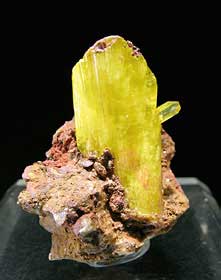
Fabre Minerals specimen and photo.
Edwards Minerals (www.edwardsminerals.com) has received a consignment lot of just five small—but truly terrific—specimens of babingtonite, no, not from the new Chinese occurrence but from an old classic one, namely the Roncari quarry, East Granby, Hartford County, Connecticut. Very sharp, very black, lustrous, doubly terminated crystals of babingtonite to more than 1 cm form stacks and clusters which rest lightly on translucent green prehnite in shapely “coxcomb” formations: possibly these are “old” pieces, but then possibly they come from a discovery of about 50 superb babingtonite/prehnite specimens in the Roncari quarry during the early 2000s.
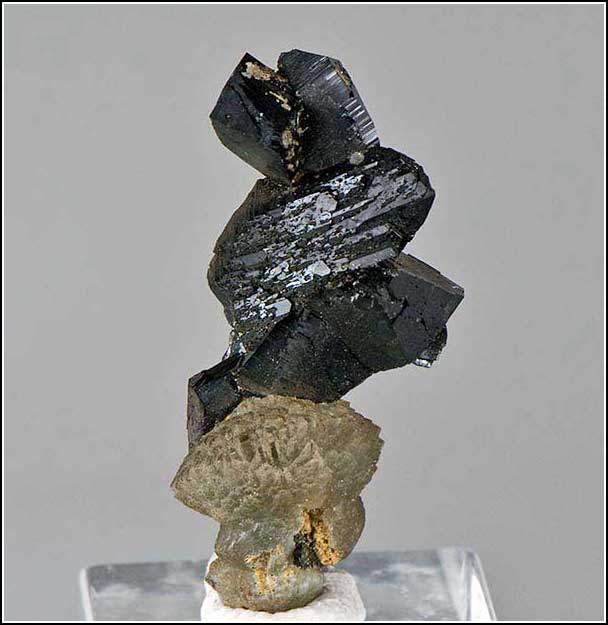
Hartford County, Connecticut. Edwards Minerals specimen and photo.
One of upstate New York’s most popular, longest-established localities is Power’s Farm, Pierrepont, St. Lawrence County, whose outstanding crystals of lustrous, jet-black uvite were first described in 1830, and have been collected intermittently ever since. In the mid-2000s, Mike Walter and Scott Wallace did much major digging at Power’s Farm, enlarging old excavations and taking out flashing clusters of uvite crystals with individuals to 6 cm. A September update of Mike’s Geologic Desires website (www.geologicdesires.com) tells of several intriguing finds from Mike’s work, this past summer, in what he calls “the phosphate trench” at Pierrepont. Most of these finds are odd-looking (okay, ugly-looking) pseudomorphs: small groups of pseudocrystals of chlorite after mica, microcline after quartz, quartz after mica, and microcline/chlorite after apatite. But the non-pseudomorphous star of the show is apatite-(CaF)(formerly known as fluorapatite), in glassy, doubly terminated, translucent yellow-brown, long-prismatic crystals to more than 2 cm, associated with black, equant uvite crystals. As the picture here testifies, these can be fairly attractive thumbnail-size specimens—and certainly they are unusual for Pierrepont, not generally known in the past for significant crystals of anything other than uvite.
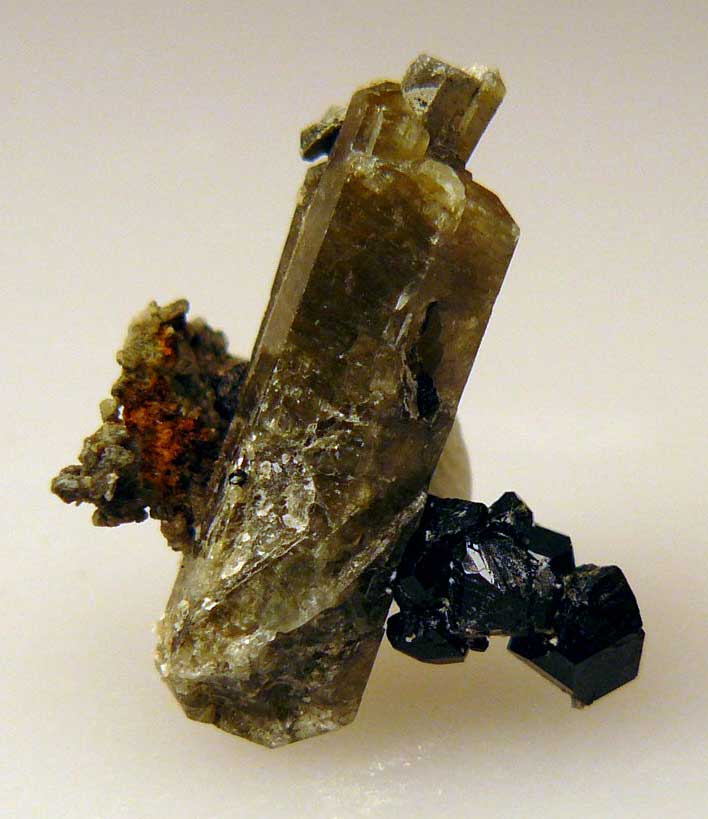
Geologic Desires specimen and photo.
Time now to welcome another newcomer, a dealership called—bluntly enough—Greekrocks (www.greekrocks.com), run by Christos Spiromitros. All sorts of goodies from Greek localities old and new may be shopped for here, but what I found most interesting were some fine-looking crystals and crystal groups of amethyst and smoky quartz from Kato Nevrokopi, Drama, Macedonia—Christos tells me in an e-mail that local collectors have been finding specimens at this locality for the past 20 years, the best known crystals having come out in 2007 and 2008. Actually (he goes on) there are two localities, not far apart, in the geographical basin called Kato Nevrokopi. At one site, near the village of Dasoto, Alpine-type fissures yield sceptered crystals of amethystine, smoky and colorless quartz to 20 cm, with “iron roses” of hematite; the other site is a skarn outcrop on Kresti Hill, near Kato Vrondou village, which yields, besides more good crystals of quartz, crystals of epidote to 7 cm, andradite crystals to 5.5 cm, pyrite crystals to 15 cm, clinochlore crystals to 1 cm, and hematite “roses” to 4.5 cm.
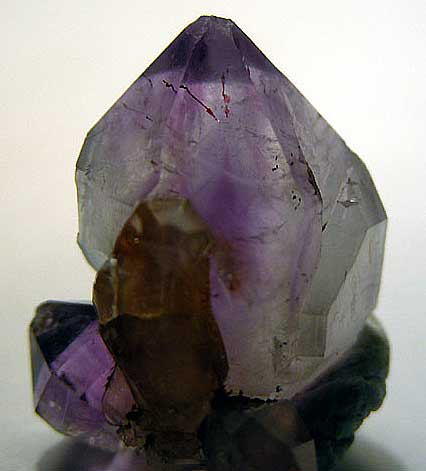
Greekrocks specimen and photo.
On the Greekrocks site there are also epidote specimens from a skarn outcrop near the village of Kimmeria, near the town of Xanthi in Thrace. At their best, Christos says, Kimmeria epidote specimens show dark green, stout, highly lustrous crystals to 10 cm, together with quartz crystals reaching 25 cm, and some Japan-law twins; a good 3.5-cm epidote crystal from Kimmeria may be seen (in a poor photograph that doubtless does not do it justice) on the website. Then there are the cabinet-size specimens of quartz, calcite, botryoidal rhodochrosite, pyrite, sphalerite, and combinations of these, from the old group of polymetallic mines near the town of Stratoni, Chalkidiki Peninsula, Macedonia. Some of these mines are still active commercially but none are any longer producing good specimens; those being offered by Greekrocks were taken out 20 to 40 years ago, and were procured by Christos from miners’ stashes. Have I convinced you yet that this is a very intriguing website?
John Veevaert’s Trinity Minerals site is always good to check out, especially after a major show (like the Denver Show just past) where John has expertly trolled around for good things to purchase and resell. This time, two lots of unusual fluorite specimens which John procured at Denver are well worth seeing. First, John offers one miniature and four cabinet-size fluorite specimens from a find recently made by Brian Huntsman at the Bingham mine, Socorro County, New Mexico: specifically, they come from what Brian calls the Fish-Stick Pocket, whose roof collapsed quite soon after he started digging, so that it’s likely that these five beautiful pieces will constitute both the beginning and end of the story. The slightly rough-surfaced, simple cubic crystals, to 5 cm on edge, are transparent and color-zoned, showing lovely magenta cores rimmed by blue-purple outer zones.
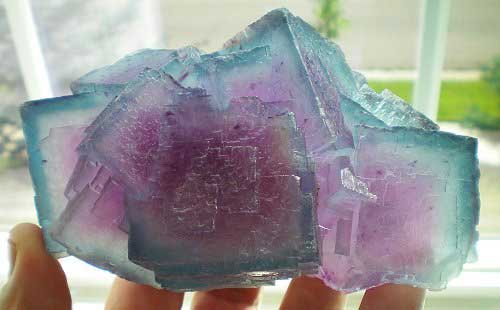
New Mexico. Trinity Minerals specimen and photo.
A separate “Fluorite” page on the Trinity Minerals site displays impressive specimens from localities including Akchatau and Kara-Oba, Kazakhstan; the Felix mine, Azusa, California; the Illinois fluorite district; and several classic German localities notably including Freiberg, Obersachsen, and the Wölsendorf mining district of the Upper Palatinate in Bavaria. Among the German fluorites too, more surprisingly, were five very pretty small miniatures and one thumbnail from a contemporary locality: the Artenberg quarry near Steinach in the Schwarzwald (Black Forest), Baden-Württemburg. John’s source told him that the specimens had been collected just recently from this road-metal quarry, and, sure enough, Bode and Wittern’s Mineralien und Fundstellen, Bundesrepublik Deutschland says that the quarry was active as of the date of the book’s publication (1989). Highly lustrous, transparent, pale green octahedral crystals of fluorite to 1.8 cm perch lightly on clusters of steep-scalenohedral crystals of calcite; some of the calcite crystals are white and opaque while others are transparent and colorless, though reddened by inclusions and exterior spottings of hematite. Wunderschön!
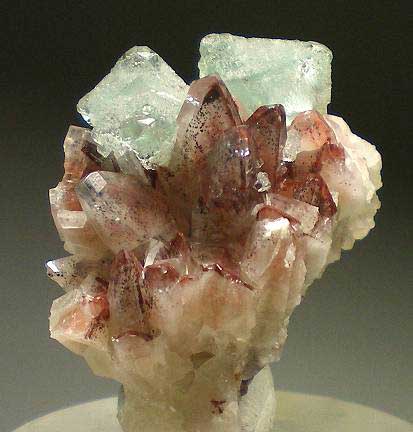
Baden-Württemburg, Germany. Trinity Minerals specimen and photo.
Well crystallized eosphorite from remote pegmatites in Pakistan has been found sparingly, and has reached the market at long intervals, since the 1990’s. Now, Brian and Brett Kosnar have acquired a handful of superb eosphorite specimens found in summer 2007 at a site near the village of Chamachhu, on the north bank of the Indus River, Skardu district, Northern Areas, and you’ll find these specimens in the September 22 update to the Kosnar boys’ Mineral Classics website (www.minclassics.com). Sharp, lustrous, pinkish to yellowish orange crystals of eosphorite, many with wedge-shaped terminations on both ends, are generally under 1 cm but more than 2 cm exceptionally; these crystals perch singly or form little sprays on druses of glistening white albite crystals which cover big, chalk-white crystals of microcline. Associated species include blue-black elbaite, topaz, manganotantalite, väyrynenite (!), and one or two unknown phosphates, all in sharp microcrystals. Most of the Kosnars’ specimens are cabinet-size, with too high a ratio of matrix area to eosphorite crystal-area for comfort…but here’s a 3.3-cm matrix with a 2.1 cm eosphorite crystal: the best specimen, with the biggest eosphorite individual, of all the pieces shown on the site.
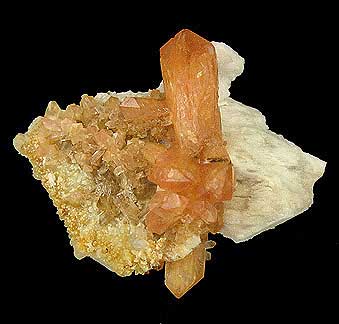
Mineral Classics specimen and photo.
Conforming to my long-established (quite arbitrary) custom, I’ll end this survey in China. Hard-working Mr. Chen Weigang has put up on his TC-China-Minerals site (www.china-mineral.cn) a page of newly found specimens of “smoky” topaz crystals lying against smoky quartz crystals, from the gem diggings on the Yunnan Province, China side of Gaoligongshan Mountain (this mountain straddles the border with Burma, and there is often some question about the country in which a given find lies—but Mr. Chen seems sure that the pieces in this instance are Chinese). The topaz crystals are fine ones—sharp, lustrous and gemmy, and reaching 5 cm—and they crowd into the sides of sharp crystals of dark smoky quartz to similar sizes. A nice aesthetic effect results from the fact that the topaz crystals are a rich, rootbeer-brown, not too far from the color of the smoky quartz and harmonizing subtly with it. These are very impressive large-miniature and small-cabinet specimens; some show the topaz and quartz crystals resting on matrix of white feldspar crystals with drusy quartz overgrowths.

TC China-Minerals specimen and photo.
Mineral Show Note
As I said in a brief note in July-August 2008, Dave Waisman’s second annual show of high-end international mineral dealers in Dallas had much to offer in May of this year—although unfortunately the attendance by buyers was less than satisfactory. Accordingly, Dave has decided to move the show to Houston next year. Details are not yet available, but if you’d like to be kept informed about the show plans in Houston and need directions or other particulars, e-mail Dave at svldave@aol.com.
While attending this show you might also, of course, look in on the great collection of the Houston Museum of Natural Science. To prepare for such an excursion, try doing some pleasant homework in Wilson, Bartsch and Mauthner’s Masterpieces of the Mineral World: Treasures from the Houston Museum of Natural Science (2004), available through the Bookstore on this website.
New Antiquarian Website
Paul Tambuyser, the Belgian enthusiast responsible for the very interesting Virtual Museum of the History of Mineralogy website (www.mineralogy.be/index.html), has established a Google-hosted discussion group called “Oryctics” for people interested in the history of mineralogy and crystallography. Topics for discussion will include antiquarian mineral books, publications and manuscripts, crystallographic goniometers and other antique crystallographic and mineralogical instruments, crystal models, and anything else related to the history of these sciences. To subscribe go to: www.mineralogy.be/oryctics.html . (You’ll need to register for a Google account as well.)
For questions about this column, please email Tom Moore.
